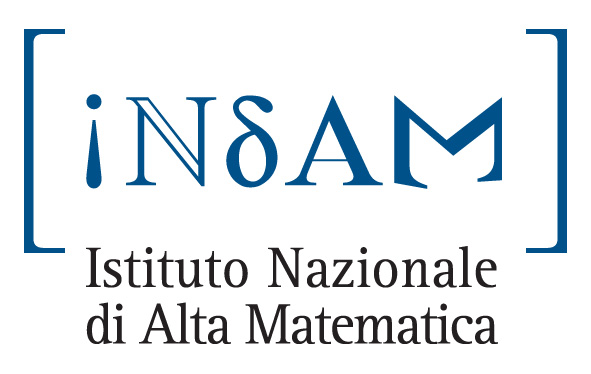
New connections between dynamical systems and Hamiltonian PDEs
NAPOLI, April 1- June 6, 2009

 |
Indam intensive period New connections between dynamical systems and Hamiltonian PDEs NAPOLI, April 1- June 6, 2009 |
 |
| Home | Speakers April-May | Speakers workshop | Timetable | Locations |
| Pietro Baldi (Università of Napoli "Federico II", Napoli, Italy): An introduction to water waves |
| Luca Biasco (Università "Roma Tre", Roma, Italy): An Introduction to KAM theory (10 hours, first week of April) |
References (can be downloaded from the web site of Jürgen Pöschel)
| James Colliander (University of Toronto, Toronto, Canada): Maximal-in-time dynamics for nonlinear Schrödinger equations |
| Piero D'Ancona (Università di Roma "La Sapienza", Roma, Italy): Introduction to dispersive equations. (20 hours) |
I will give a self-contained introduction to modern techniques in the study of evolution equations of dispersive type; the main examples being the Schroedinger, wave, Klein-Gordon, Dirac and KdV equations. I will touch the following topics:
| Norman Dancer (University of Sydney, Sidney, Australia): Local and global bifurcation for nonlinear mappings and applications (5 lectures, May 25-29) |
The basic global bifurcation theorem, the effect of symmetries, global bifurcation theorems where there are both symmetries and variational structure, applications to periodic solutions.
| Amadeu Delshams (Universitat Politècnica de Catalunya, Barcelona, Spain): Instability in Hamiltonian systems via geometrical methods (2 lectures, April 15-18) |
I will describe two different settings where the geometrical methods can be applied to detect (global) instability: a priori chaotic and a priori unstable Hamiltonian systems. A very wide class of geodesic flows in any dimension plus a quasi-periodic perturbation give rise to a priori chaotic Hamiltonian system, whereas a priori unstable Hamiltonian systems take place in considering periodic perturbations of a (or some) pendulum plus a (or some) rotor.
In both cases, there is a very big invariant object called *NHIM* (normally hyperbolic invariant manifold), which apart from its inner dynamics, possesses an outer dynamics, due to the transversal intersection of its associated unstable and stable invariant manifolds, which is described by the so called *scattering map*.
The combination of both dynamics along the *NHIM* gives rise to chaotic and unstable global behavior.
References (available from http://www.ma1.upc.edu/~amadeu/):
| Lars-Hakan Eliasson (Paris VII, Paris, France): Quasi-periodic Schrödinger operators (5 lectures, May 18-22) |
The lecture will treat the one-dimensional quasi-periodic Schrödinger operator and its relation to the Schrödinger co-cycle and the Schrödinger equation.
We shall present the rotation number and the Lyapunov exponent, and we shall shortly discuss their relations to spectral and dynamical properties [3]). This by now almost classical subject is well covered in the books [5] and [2].
The major part of the lectures will be devoted to the perturbation theory of this operator [4] in the two regimes:
If time permits we will discuss the relation of the perturbative results with the semi-perturbative results obtained recently in, for example, [1].
References
| Patrick Gerard (Paris-Sud, Paris, France): The Cauchy Problem for Weakly Dispersive Nonlinear Schrödinger Equations, (5 lectures, May 25-29) |
Existence of smooth flow maps and bilinear Strichartz estimates on manifolds
The cubic Szegö equation: an integrable toy model for completely non dispersive Hamiltonian evolutions
| Gerard Iooss (I.U.F., Université de Nice): An example of infinite dimensional reversible system: Water wave theory, (3 lectures, May 25-29) |
The introduction of spatial dynamics (K.Kirchgässner in the eighties) allowed big progresses in the mathematical theory of water waves. Several new forms of localized waves were discovered. The two first talks will give elements of the reduction methods (center manifold reduction and normal forms for infinite dimensional reversible systems) and examples of results for travelling waves in 2D and 3D water vave theory. For the 3D problem, the limiting case with no surface tension introduces a small divisor problem and the above reduction methods fail. This situation will be the subject of the last lecture which will present the method and results on travelling gravity waves with a horizontally periodic pattern.
Reference
| Thomas Kappeler (ETH Zurich, Switzerland), Jürgen Pöschel (University of Stuttgart, Germany): Normal form theory of the defocusing nonlinear Schrödinger equation, (5 lectures, May 18-22) |
Our lectures are based on a book in preparation. Parts of the manuscript will be distributed to the students attending the lectures.
Lecture 1: Introduction
In the first lecture we will review the notion of integrable systems of
finite dimension and their normal forms.
Lecture 2: Nonlinear Schrödinger equation (NLS)
In the second lecture we explain how the nonlinear Schrödinger
equation on the circle can be viewed as a Hamiltonian system and show that
it can be written as a Lax pair, involving the so called Zhakarov Shabat
operator. For the defocusing NLS, this operator is self-adjoint. Its
properties, in particular its spectrum when considered with periodic or
Dirichlet boundary conditions will be discussed.
Lecture 3 and 4: Birkhoff normal form of NLS
In the third and fourth lecture we will present a quite general scheme how
to construct Birkhoff coordinates for the defocusing NLS on the circle.
They turn out to be globally defined.
Lecture 5: Applications
In the last lecture we will discuss applications of the Birkhoff
coordinates to the well-posedness problem of the defocusing NLS on the
circle in weighted Sobolev spaces. If time permits we will also discuss a
KAM theorem for NLS.
| Evgeny Korotyaev (Cardiff Univ., UK): Hamiltonian for KDV as a function of Marchenko-Ostrovki parameters. (1 talk) |
We consider the KdV equation with periodic initial conditions. We study the Hamiltonian as an analytic function of Marchenko-Ostrovki parameters. Here the analysis of the Löwner equation for the quasimonentum of the corresponding Hill operator is important. We apply these results to study the action variables for the KdV equation. The similar results are obtained for non-linear Schrodinger equation.
In a joint research with Sergei Kuksin we plan to use these results to study a Birkhoff coordinate system on the space of periodic functions.
| Sergei B. Kuksin (École Polytechnique, Palaiseau, France): KAM for PDEs (5 lectures, May 25-29) |
| Alessandro Portaluri (Università del Salento, Lecce, Italy): Introduction to symplectic invariants. (8 hours, May 11-15) |
The main aim of this course is to introduce some classical results of the exterior derivative d on manifolds, Lie derivatives and the Lemma of Poincaré. Then, we shall use them in the Hamiltonian formalism. Finally we shall describe the Leray-Schauder mapping degree.
| Alfonso Sorrentino (Paris IX, Paris, France): An introduction to Mather's theory. (8 hours) |
The main aim of this course is to present a brief, but hopefully comprehensive, introduction to Mather's variational method for the study of convex Lagrangian and Hamiltonian systems.
First, we shall introduce the concepts of action-minimizing invariant probability measure and action-minimizing curve, prove their existence and discuss their dynamical properties. Then, we shall use them to define infinite families of invariant subsets of the phase space - i.e. the Mather sets, the Aubry sets and the Mane sets - and see in which sense they generalize KAM tori.
Finally, we shall discuss how the same results can be also obtained from the study of viscosity solutions and subsolutions of Hamilton- Jacobi equation (Fathi's weak KAM theory) or from a more symplectic point of view.
Applications to integrable and quasi-integrable Hamiltonian systems and to the study of invariant Lagrangian graphs will be presented.
| Eduard J. Zehnder (ETH Zurich): Periodic orbits of Hamiltonian systems and symplectic invariants, (5 lectures, May 18-22) |
The lectures will be about symplectic invariants and global periodic orbits of Hamiltonian systems on hypersurfaces of symplectic manifolds.
More precisely, we will construct the so called dynamical symplectic capacities and apply them to Hamiltonian systems. The construction will be based on a Mini-Max principle for the action functional of classical mechanics, the necessary Sobolev space techniques will be introduced.
The lectures require only standard techniques from differential geometry, functional analysis and Hamiltonian systems.
All the material presented is contained in the book: H. Hofer and E. Zehnder, Symplectic invariants and Hamiltonian Dynamics, Birkhäuser advanced texts, 1994.